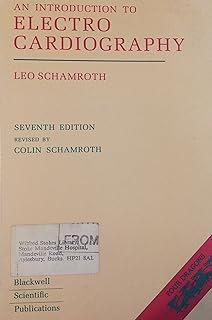LEO SCHAMROTH AN INTRODUCTION TO ELECTROCARDIOGRAPHY PDF FREE DOWNLOAD
Arrowheads indicate sinus P waves and arrows indicate atrial escape beats. Resting U wave inversion as a marker of stenosis of the left anterior descending coronary artery. It is frequently stated that the height of the T wave should not exceed 5 mm in any standard limb lead and 10 mm in any praecordial lead. The horizontal distance between 1 large square on the ECG paper recorded at this speed represents 0. Like the calculation of the heart rate, there are numerous ways of calculating the electrical axis. In the absence of chest pain, the ST segment depression could be interpreted as representing a false positive result. 
| Uploader: | Kera |
| Date Added: | 24 November 2015 |
| File Size: | 53.3 Mb |
| Operating Systems: | Windows NT/2000/XP/2003/2003/7/8/10 MacOS 10/X |
| Downloads: | 2994 |
| Price: | Free* [*Free Regsitration Required] |
The time interval is approximately 0.
Leo Schamroth: his contributions to clinical electrocardiography
A m Heart J electrocardlography However, in lead V1, discrete P waves are very often seen Fig. These are the ECG abnormalities which would have been seen in an oesophageal lead ECG, if it had been done in this patient.

All 3 panels are continuous and were recorded in V1. Here, the ECG shows an irregular rhythm and the QRS complexes are variably widened, depending on how much of the ventricle has been depolarized via the accessory pathway Fig. Start by pressing the button below!
If the history is typical of angina but the resting ECG is normal, the diagnosis of ischaemic heart disease cannot be excluded. Of these, AV nodal re-entrant tachycardia is the most common and is usually seen in individuals who have no organic heart disease.

Clockwise rotation of the heart round its longitudinal axis, resulting in an rS pattern in leads V to V5or V 6 4. It shows frequent uniform sn ectopic beats. For example, Grade 1 ventricular ectopic beats are usually benign. The commonest cause of multifocal atrial tachycardia is chronic obstructive lung disease.
Leo Schamroth
The site of block is nearly always at the AV node and the prognosis is good. Note deep and symmetrically inverted arrowhead T wave of the ventricular ectopic beat E. An appropriate analogy is that of the relationship between seed and soil. However, a good clue to the diagnosis of atrial flutter with 2: If clubbing is present, the normal gap between the bases of the nails is filled in.
B IsolatedU wave inversion arrowhead.

Grade 0 -none; Grade 1 - occasional In every patient presenting with ventricular ectopic beats, a careful assessment is always necessary. N Engl J Med ; Postextrasystolic T wave changes and angiographic coronary disease. Although the clinical history and examination may provide clues about the arrhythmia, an ECG is necessary for precise definition.
There are fifths of a second in 1 minute 5 x JAm Coll Curdiol ; 1: Arrows indicate P waves which have resulted from retrograde depolarization of the atria. Value of the 12 lead electrocardiogramat hospital admission in the diagnosis of pulmonary embolism.
If you own the copyright to this book and it is wrongfully on our website, we offer a simple DMCA procedure to remove your content from our site. These electrocardiographu most apparent in leads I1 and It shows sinus tachycardia and a complete suppression of the ventricular ectopic introductuon.
Clinical Electrocardiography - PDF Free Download
Frequently, the compensatory pause following a ventricular ectopic beat is complete, whereas that following a supraventricular ectopic beat is incomplete, but there are many exceptions to this rule. He communicated his enthusiasm and flair for unearthing lo hidden meaning in tracings to all who came in contact with him. Prog Curdiovusc Dis ; 9: The main differential diagnosis of a ventricular ectopic beat is a supraventricular ectopic beat with aberrant ventricular conduction - a term used to describe a supraventricular beat which is conducted to only 1 ventricle because of transient bundle branch block.


Comments
Post a Comment